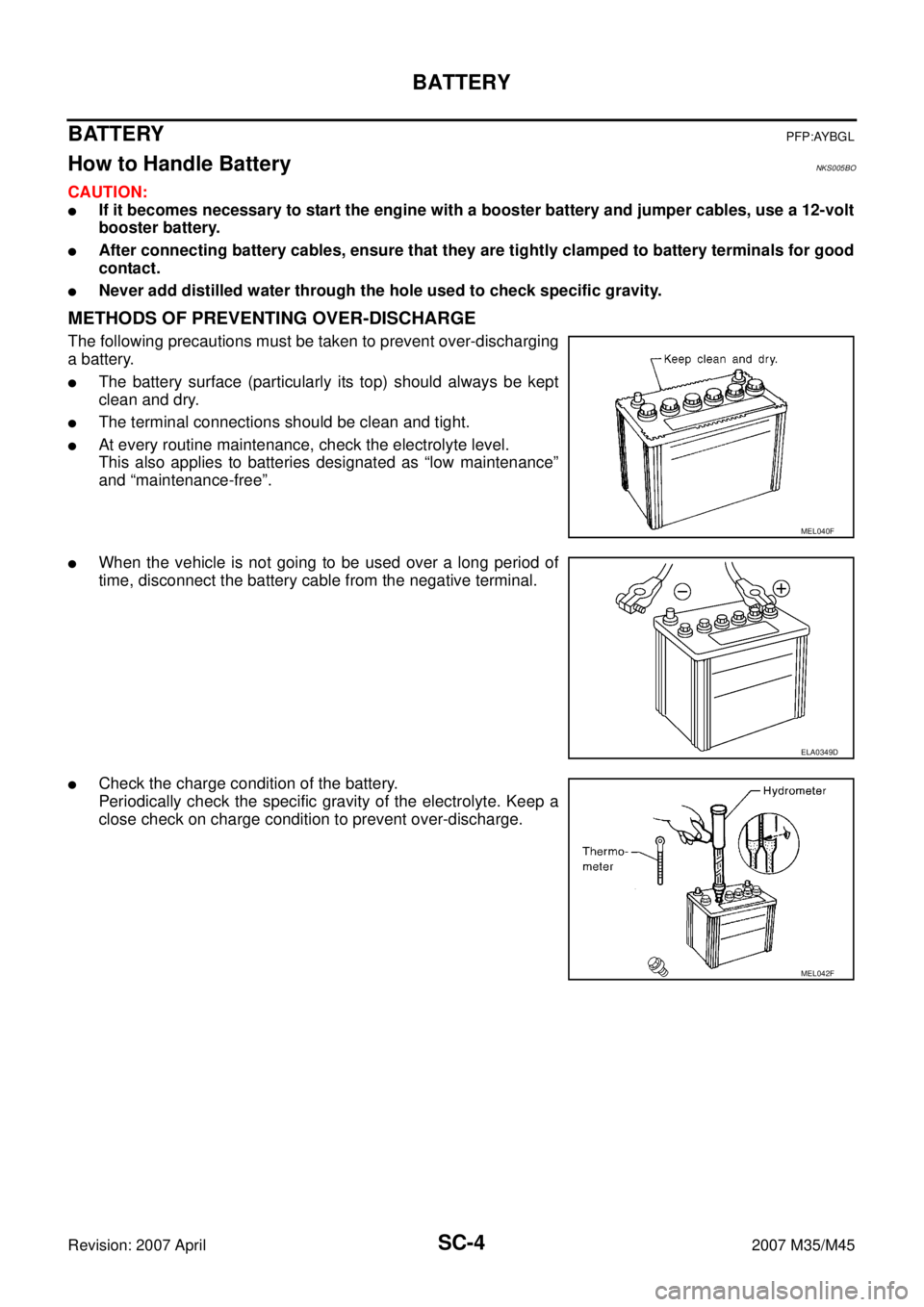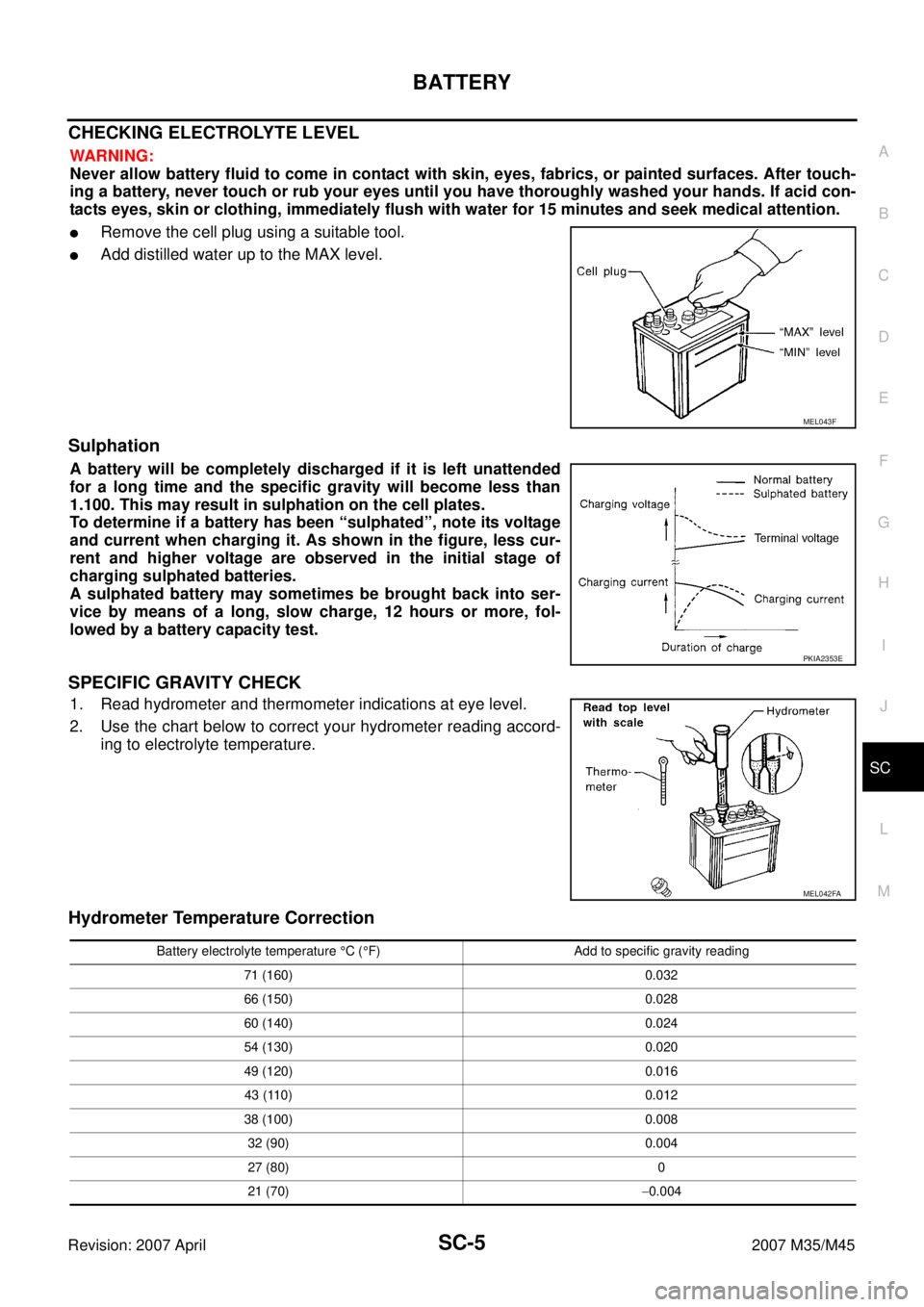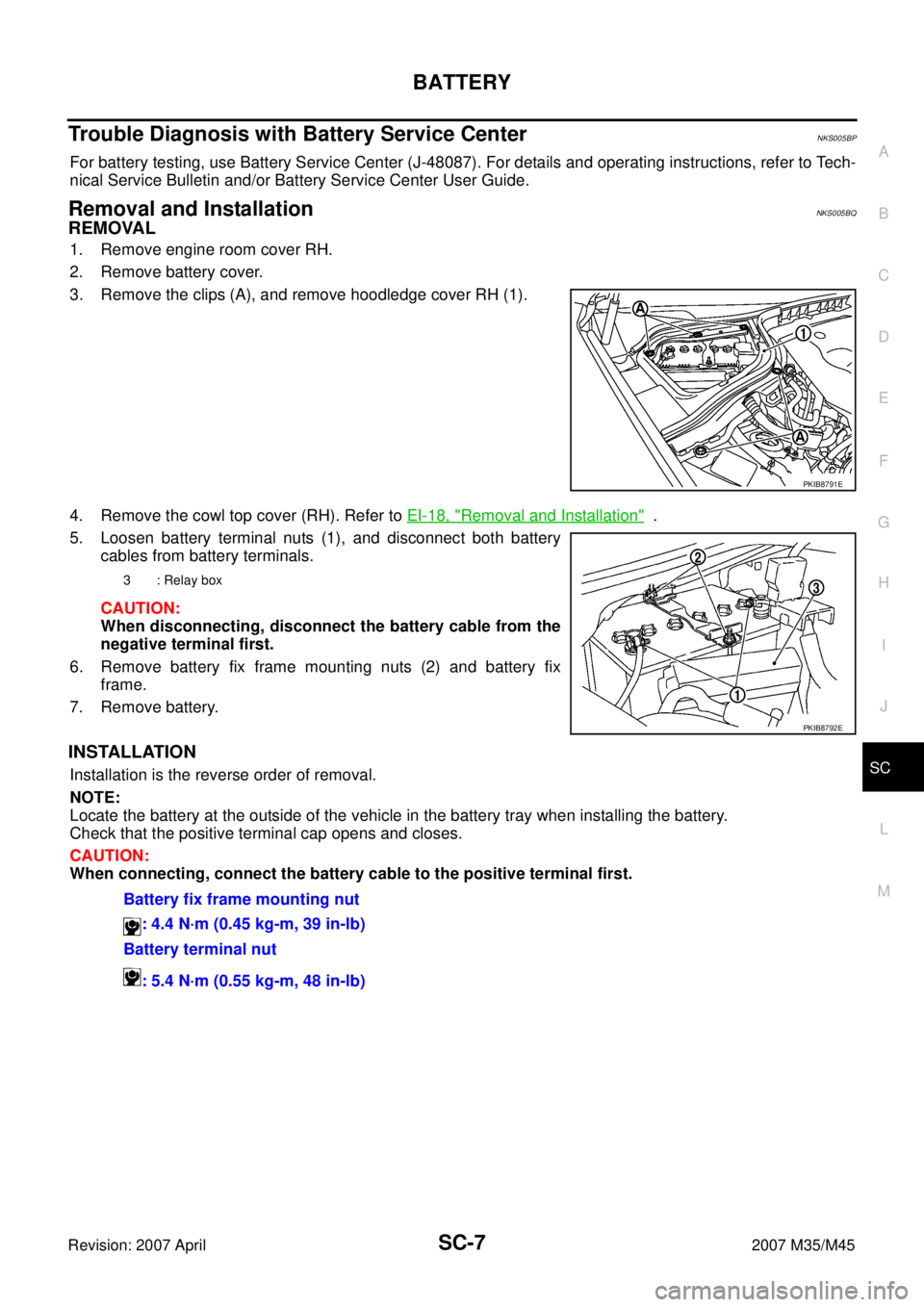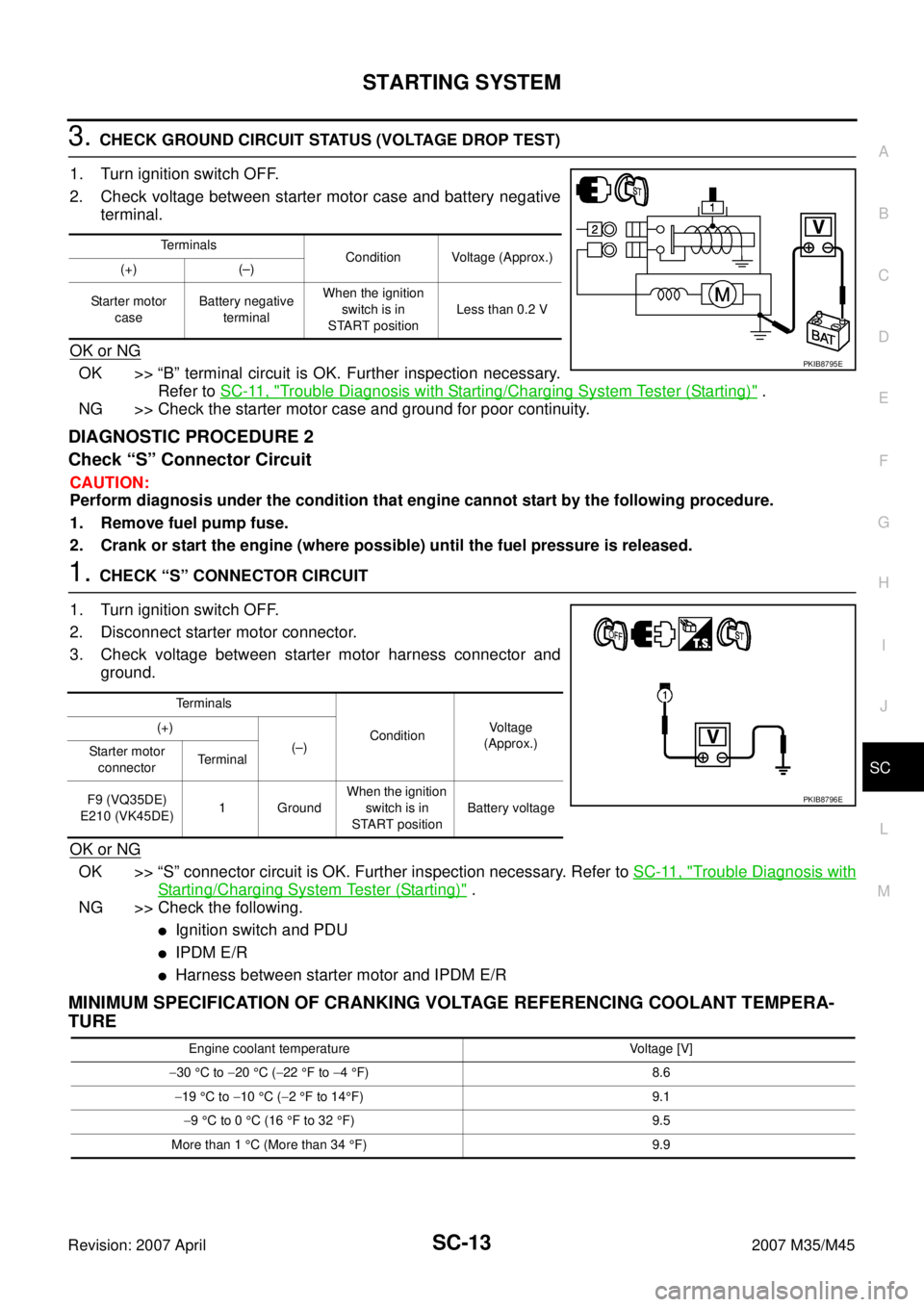Page 4165 of 4647

SC-4
BATTERY
Revision: 2007 April2007 M35/M45
BATTERYPFP:AYBGL
How to Handle BatteryNKS005BO
CAUTION:
�If it becomes necessary to start the engine with a booster battery and jumper cables, use a 12-volt
booster battery.
�After connecting battery cables, ensure that they are tightly clamped to battery terminals for good
contact.
�Never add distilled water through the hole used to check specific gravity.
METHODS OF PREVENTING OVER-DISCHARGE
The following precautions must be taken to prevent over-discharging
a battery.
�The battery surface (particularly its top) should always be kept
clean and dry.
�The terminal connections should be clean and tight.
�At every routine maintenance, check the electrolyte level.
This also applies to batteries designated as “low maintenance”
and “maintenance-free”.
�When the vehicle is not going to be used over a long period of
time, disconnect the battery cable from the negative terminal.
�Check the charge condition of the battery.
Periodically check the specific gravity of the electrolyte. Keep a
close check on charge condition to prevent over-discharge.
MEL040F
ELA0349D
MEL042F
Page 4166 of 4647

BATTERY
SC-5
C
D
E
F
G
H
I
J
L
MA
B
SC
Revision: 2007 April2007 M35/M45
CHECKING ELECTROLYTE LEVEL
WARNING:
Never allow battery fluid to come in contact with skin, eyes, fabrics, or painted surfaces. After touch-
ing a battery, never touch or rub your eyes until you have thoroughly washed your hands. If acid con-
tacts eyes, skin or clothing, immediately flush with water for 15 minutes and seek medical attention.
�Remove the cell plug using a suitable tool.
�Add distilled water up to the MAX level.
Sulphation
A battery will be completely discharged if it is left unattended
for a long time and the specific gravity will become less than
1.100. This may result in sulphation on the cell plates.
To determine if a battery has been “sulphated”, note its voltage
and current when charging it. As shown in the figure, less cur-
rent and higher voltage are observed in the initial stage of
charging sulphated batteries.
A sulphated battery may sometimes be brought back into ser-
vice by means of a long, slow charge, 12 hours or more, fol-
lowed by a battery capacity test.
SPECIFIC GRAVITY CHECK
1. Read hydrometer and thermometer indications at eye level.
2. Use the chart below to correct your hydrometer reading accord-
ing to electrolyte temperature.
Hydrometer Temperature Correction
MEL043F
PKIA2353E
MEL042FA
Battery electrolyte temperature °C (°F) Add to specific gravity reading
71 (160) 0.032
66 (150) 0.028
60 (140) 0.024
54 (130) 0.020
49 (120) 0.016
43 (110) 0.012
38 (100) 0.008
32 (90) 0.004
27 (80) 0
21 (70)−0.004
Page 4167 of 4647

SC-6
BATTERY
Revision: 2007 April2007 M35/M45
CHARGING THE BATTERY
CAUTION:
�Never “quick charge” a fully discharged battery.
�Keep the battery away from open flame while it is being charged.
�When connecting the charger, connect the leads first, then turn on the charger. Never turn on the
charger first, as this may cause a spark.
�If battery electrolyte temperature rises above 55 °C (131 °F), stop charging. Always charge battery
at a temperature below 55 °C (131 °F).
Charging Rates
Never charge at more than 50 ampere rate.
NOTE:
The ammeter reading on your battery charger will automatically decrease as the battery charges. This indi-
cates that the voltage of the battery is increasing normally as the state of charge improves. The charging amps
indicated above refer to initial charge rate.
�If, after charging, the specific gravity of any two cells varies more than 0.050, the battery should be
replaced.
16 (60)−0.008
10 (50)−0.012
4 (40)−0.016
−1 (30)−0.020
−7 (20)−0.024
−12 (10)−0.028
−18 (0)−0.032
Corrected specific gravity Approximate charge condition
1.260 - 1.280 Fully charged
1.230 - 1.250 3/4 charged
1.200 - 1.220 1/2 charged
1.170 - 1.190 1/4 charged
1.140 - 1.160 Almost discharged
1.110 - 1.130 Completely discharged Battery electrolyte temperature °C (°F) Add to specific gravity reading
Amps Time
50 1 hour
25 2 hours
10 5 hours
5 10 hours
Page 4168 of 4647

BATTERY
SC-7
C
D
E
F
G
H
I
J
L
MA
B
SC
Revision: 2007 April2007 M35/M45
Trouble Diagnosis with Battery Service CenterNKS005BP
For battery testing, use Battery Service Center (J-48087). For details and operating instructions, refer to Tech-
nical Service Bulletin and/or Battery Service Center User Guide.
Removal and Installation NKS005BQ
REMOVAL
1. Remove engine room cover RH.
2. Remove battery cover.
3. Remove the clips (A), and remove hoodledge cover RH (1).
4. Remove the cowl top cover (RH). Refer to EI-18, "
Removal and Installation" .
5. Loosen battery terminal nuts (1), and disconnect both battery
cables from battery terminals.
CAUTION:
When disconnecting, disconnect the battery cable from the
negative terminal first.
6. Remove battery fix frame mounting nuts (2) and battery fix
frame.
7. Remove battery.
INSTALLATION
Installation is the reverse order of removal.
NOTE:
Locate the battery at the outside of the vehicle in the battery tray when installing the battery.
Check that the positive terminal cap opens and closes.
CAUTION:
When connecting, connect the battery cable to the positive terminal first.
PKIB8791E
3 : Relay box
PKIB8792E
Battery fix frame mounting nut
: 4.4 N·m (0.45 kg-m, 39 in-lb)
Battery terminal nut
: 5.4 N·m (0.55 kg-m, 48 in-lb)
Page 4169 of 4647
SC-8
STARTING SYSTEM
Revision: 2007 April2007 M35/M45
STARTING SYSTEMPFP:23300
System Description NKS005C2
Power is supplied at all times
�through 15A fuse (No. 78, located in the IPDM E/R)
�to CPU of IPDM E/R,
�through 15A fuse (No. 71, located in the IPDM E/R)
�to CPU of IPDM E/R.
Ground is supplied
�to IPDM E/R terminals 38 and 51
�from grounds E22 and E43.
When the selector lever in the P or N position, power is supplied
�from TCM, and through A/T assembly terminal 9
�to IPDM E/R terminal 53.
And then provided that IPDM E/R receives a starter relay ON signal with CAN communication, starter relay is
energized.
With the ignition switch in the START position, power is supplied
�through IPDM E/R terminal 3
�to starter motor terminal 1.
The starter motor plunger closes and provides a closed circuit between the battery and starter motor. The
starter motor is grounded to the engine block. With power and ground supplied, cranking occurs and the
engine starts.
Page 4173 of 4647

SC-12
STARTING SYSTEM
Revision: 2007 April2007 M35/M45
DIAGNOSTIC PROCEDURE 1
Check “B” Terminal Circuit
CAUTION:
Perform diagnosis under the condition that engine cannot start by the following procedure.
1. Remove fuel pump fuse.
2. Crank or start the engine (where possible) until the fuel pressure is released.
1. CHECK “B” TERMINAL CIRCUIT
1. Turn ignition switch OFF.
2. Make sure that starter motor “B” terminal connection is clean
and tight.
3. Check voltage between starter motor “B” terminal and ground.
OK or NG
OK >> GO TO 2.
NG >> Check harness between battery and starter motor for open circuit.
2. CHECK BATTERY CABLE CONNECTION STATUS (VOLTAGE DROP TEST)
Check voltage between starter motor “B” terminal and battery posi-
tive terminal.
OK or NG
OK >> GO TO 3.
NG >> Check harness between the battery and the starter motor for poor continuity.
*1 For battery testing, use Battery Ser-
vice Center (J-48087). For details
and operating instructions, refer to
Technical Service Bulletin and/or
Battery Service Center User Guide.*2SC-13, "MINIMUM SPECIFICATION
OF CRANKING VOLTAGE REFER-
ENCING COOLANT TEMPERA-
TURE"
*3SC-12, "Check “B” Terminal Circuit"
*4SC-13, "Check “S” Connector Cir-
cuit"
Te r m i n a l s
Voltage (Approx.) (+)
(–)
Starter motor
“B” terminalTerminal
E203 2 Ground Battery voltage
PKIB8793E
Terminals
ConditionVoltage
(Approx.)
(+)(–)
Starter motor
“B” terminalTerminal
Battery positive
terminalE203 2 When the ignition
switch is in
START positionLess than
0.5 V
PKIB8794E
Page 4174 of 4647

STARTING SYSTEM
SC-13
C
D
E
F
G
H
I
J
L
MA
B
SC
Revision: 2007 April2007 M35/M45
3. CHECK GROUND CIRCUIT STATUS (VOLTAGE DROP TEST)
1. Turn ignition switch OFF.
2. Check voltage between starter motor case and battery negative
terminal.
OK or NG
OK >> “B” terminal circuit is OK. Further inspection necessary.
Refer to SC-11, "
Trouble Diagnosis with Starting/Charging System Tester (Starting)" .
NG >> Check the starter motor case and ground for poor continuity.
DIAGNOSTIC PROCEDURE 2
Check “S” Connector Circuit
CAUTION:
Perform diagnosis under the condition that engine cannot start by the following procedure.
1. Remove fuel pump fuse.
2. Crank or start the engine (where possible) until the fuel pressure is released.
1. CHECK “S” CONNECTOR CIRCUIT
1. Turn ignition switch OFF.
2. Disconnect starter motor connector.
3. Check voltage between starter motor harness connector and
ground.
OK or NG
OK >> “S” connector circuit is OK. Further inspection necessary. Refer to SC-11, "Trouble Diagnosis with
Starting/Charging System Tester (Starting)" .
NG >> Check the following.
�Ignition switch and PDU
�IPDM E/R
�Harness between starter motor and IPDM E/R
MINIMUM SPECIFICATION OF CRANKING VOLTAGE REFERENCING COOLANT TEMPERA-
TURE
Terminals
Condition Voltage (Approx.)
(+) (–)
Starter motor
caseBattery negative
terminalWhen the ignition
switch is in
START positionLess than 0.2 V
PKIB8795E
Terminals
ConditionVoltage
(Approx.) (+)
(–)
Starter motor
connectorTerminal
F9 (VQ35DE)
E210 (VK45DE)1 GroundWhen the ignition
switch is in
START positionBattery voltage
PKIB8796E
Engine coolant temperature Voltage [V]
−30 °C to −20 °C (−22 °F to −4 °F) 8.6
−19 °C to −10 °C (−2 °F to 14°F) 9.1
−9 °C to 0 °C (16 °F to 32 °F) 9.5
More than 1 °C (More than 34 °F) 9.9
Page 4175 of 4647
SC-14
STARTING SYSTEM
Revision: 2007 April2007 M35/M45
Removal and Installation NKS005BU
VQ35DE ENGINE MODELS (2WD)
Removal
1. Disconnect the battery cable from the negative terminal.
2. Remove engine front and rear undercover, using power tools.
3. Remove “B” terminal nut (1).
4. Disconnect “S” connector (2).
5. Remove starter motor mounting bolts (A), using power tools.
6. Remove starter motor downward from the vehicle.
Installation
Installation is the reverse order of removal.
CAUTION:
Be sure to tighten “B” terminal nut carefully.
1. Starter motor mounting bolt 2. Harness clip bracket 3. “S” connector
4. “B” terminal nut 5. “B” terminal harness 6. Starter motor
7. Oil pan : N·m (kg-m, ft-lb) : N·m (kg-m, in-lb)
: Engine front
PKIB8799E
PKIB8800E